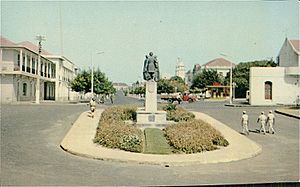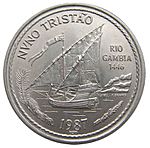Nuno Tristão facts for kids
Nuno Tristão was a Portuguese explorer and slave trader who lived in the 1400s. He was active in the early 1440s. Many people believed he was the first European to reach the Guinea region. Some even thought he reached as far as Guinea-Bissau. However, newer historians think he probably didn't go past the Gambia River.
Contents
First Journey of Exploration
Nuno Tristão was a knight who worked for Prince Henry. In 1441, Prince Henry sent Tristão on a journey. He sailed in a new type of ship called a caravel. This ship had special sails that made it good for exploring.
Tristão's mission was to explore the West African coast. He was to go beyond Cape Barbas, which was the furthest point reached by another explorer five years earlier.
Near a place called Rio de Oro, Tristão met another ship. This ship was led by Antão Gonçalves. Gonçalves had been sent to hunt monk seals. But he had also captured a young camel driver. This was the first local person the Portuguese had met since their explorations began.
Nuno Tristão had a Moorish servant on his ship. This servant could speak different languages and acted as an interpreter. Tristão used the interpreter to question the camel driver. The camel driver told them about a nearby fishing camp.
The Portuguese explorers attacked the camp. They took about ten people captive. These were the first African people taken back to Europe by the Portuguese. After this, Gonçalves returned to Portugal. But Nuno Tristão kept going south. He reached Cape Blanc before turning back.
Second Journey
In 1443, Prince Henry sent Nuno Tristão on another journey. This time, Tristão sailed past Cape Blanc. He reached the Bay of Arguin.
On Arguin island, Tristão found a village. This was the first permanent settlement that Henry's captains had seen on the West African coast. Tristão immediately attacked the village. He took about fourteen villagers captive. Then he returned to Portugal with them.
Tristão's report made many Portuguese merchants interested. They saw that it was easy to capture people in the Arguin area. They asked Prince Henry for permission to trade for captives. Between 1444 and 1446, many Portuguese ships went to the Arguin Bay area for this purpose.
Third Journey
The fishing villages around Arguin were quickly affected by the Portuguese. So, in 1445, Nuno Tristão was sent even further south. His goal was to find new places to take captives.
Tristão sailed as far south as the borderlands of Senegal. This is where the Sahara desert ends and forests begin. The people living along the coast also changed. They were no longer the 'tawny' Sanhaja Berbers. Now they were 'black' Wolofs.
It is thought that Tristão reached a place called Ponta da Berberia. This was just before the entrance to the Senegal River. Bad weather stopped him from entering the river or landing there. So, he sailed back home. On his way, Tristão stopped at the Arguin banks again. He took another 21 Berbers captive.
When Nuno Tristão arrived in Portugal, he announced his discovery. He had found sub-Saharan Africa. At that time, it was called the "Land of the Blacks" or simply Guinea. Portuguese traders quickly went to the Senegalese coast. But they found the local people were ready and better armed. So, taking captives there was not as easy or profitable as they had hoped.
Fourth Journey and Death
In 1446 (though the exact year is uncertain), Nuno Tristão began his fourth and final trip. He sailed down the West African coast. South of Cap Vert, Tristão found the mouth of a large river.
Tristão took 22 sailors with him in a small boat called a launch. They went upriver to look for a settlement to raid. But their boat was ambushed. Thirteen native canoes with about 80 armed men surrounded them. Nuno Tristão and most of his crew were killed right away by poisoned arrows. Only two might have escaped.
Tristão's main ship, the caravel, was left with only a few crew members. A clerk named Aires Tinoco and four young grumetes (ship boys) were left. They immediately sailed back to Portugal. However, another explorer, Diogo Gomes, tells a different story. He said the caravel never made it back. He claimed the native canoes took over the ship, dragged it upriver, and took it apart.
It is not fully known how far Nuno Tristão sailed or exactly where he died. For a long time, Portuguese tradition said Tristão died at the Rio do Nuno (Nunez River, in modern Guinea). Or they said he died just before it, at the Rio Grande (Geba River, Guinea-Bissau). Because of this, Nuno Tristão was often called the 'discoverer' of Portuguese Guinea (modern Guinea-Bissau). Some even said he was the first European to step on the land where the city of Bissau is today. If this were true, Tristão's last journey would have been a huge step forward for Portuguese exploration.
However, modern historians have looked at more evidence. This includes stories from Diogo Gomes and Cadamosto. They generally believe that Nuno Tristão only reached the Sine-Saloum delta in Senegal. This is just a few kilometers south of Cape of Masts. At most, they think he reached the Gambia River.
The exact spot of his death is still debated. Historian Teixeira da Mota thought Tristão first explored the Saloum River. Then he sent his small boat up the Diombos River. The south bank of this river was controlled by the Mandinka king, Niumimansa. It was these Mandinka warriors who ambushed and killed Nuno Tristão. Other experts believe the Serer people of Senegambia were responsible for killing the Portuguese raiders. This is the most common belief today.
Nuno Tristão was Prince Henry's favorite captain. His death marked a turning point. Another group of ships went out the next year, but they also suffered many losses. Because of this, Portuguese expeditions were stopped for a while. Prince Henry did not send another expedition to the West African coast until ten years later, in 1455.
See also
 In Spanish: Nuno Tristão para niños
In Spanish: Nuno Tristão para niños



